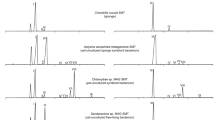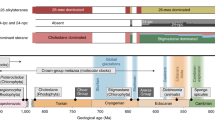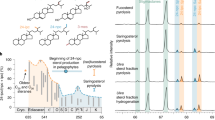Abstract
THE steranes present in crude oils and sedimentary rocks are believed to be derived from the sterols of ancient organisms. Their precise structure and stereochemistry may give important clues about the nature of the original biological materials and about the geochemical processes which they have undergone. Examination of synthetic steranes1,2 has led us to question the adequacy of reported3–6 identifications, using only gas–liquid chromatography (GC) and mass spectroscopy (MS), of steranes such as 5α-cholestane, 5α-ergostane, and 5α-stigmastane ( =5α-sitostane) in geological samples. The last two, in particular, seem incompletely identified, since the configuration at C-24 has been ignored (although it is of phylogenetic importance in modern organisms7,8), and since we find that epimers at C-24, that is II and III, IV and V, are indistinguishable using GC and MS. The use of the names 5α-ergostane and 5α-stigmastane in geochemical work both for steranes of undetermined configuration at C-24 and for synthetic samples of defined configuration is confusing. In the absence of clear IUPAC/IUB rules, we have adopted the names shown in Fig. 1.
This is a preview of subscription content, access via your institution
Access options
Subscribe to this journal
Receive 51 print issues and online access
$199.00 per year
only $3.90 per issue
Buy this article
- Purchase on Springer Link
- Instant access to full article PDF
Prices may be subject to local taxes which are calculated during checkout
Similar content being viewed by others
References
Mulheirn, L. J., Tetrahedron Lett., 3175–3178 (1973).
Mulheirn, L. J., and Ryback, G., J. chem. Soc. Chem. Comm., 886–887 (1974).
Hills, I. R., Smith, G. W., and Whitehead, E. V., J. Instn Petrol., 56, 127–137 (1970).
Ikan, R., and Bortinger, A., Israel J. Chem., 9, 679–682 (1971).
Gallegos, E. J., Analyt. Chem., 43, 1151–1160 (1971).
Maxwell, J. R., Pillinger, C. T., and Eglinton, G., Q. Rev. chem. Soc., 25, 571–628 (1971).
Goad, L. J., and Goodwin, T. W., Prog. Phytochem., 3, 113–198 (1972).
Nes, W. R., Lipids, 9, 596–612 (1974).
Eardley, A. J., Spec. Stud. Utah geol. mineral. Surv., 5 (1963).
Hoering, T. C., Yb. Carnegie Instn Wash., 303–307 (1969).
Philippi, G. T., Geochim. cosmochim. Acta, 29, 1021–1049 (1965).
Balogh, B., Wilson, D. M., and Burlingame, A. L., Nature, 233, 261–263 (1971).
Maxwell, J. R., Cox, R. E., Ackman, R. G., and Hooper, S. N., in Advances in Organic Geochemistry 1971 (edit. by von Gaertner, H. R., and Wehner, H.), 277–291 (Pergamon, Oxford, 1972).
Bradley, W. H., Bull. geol. Soc. Am., 81, 985–1000 (1970).
Van Horn, A. R., and Djerassi, C., J. Am. chem. Soc., 89, 651–664 (1967).
Author information
Authors and Affiliations
Rights and permissions
About this article
Cite this article
MULHEIRN, L., RYBACK, G. Stereochemistry of some steranes from geological sources. Nature 256, 301–302 (1975). https://doi.org/10.1038/256301a0
Received:
Accepted:
Issue Date:
DOI: https://doi.org/10.1038/256301a0
This article is cited by
Comments
By submitting a comment you agree to abide by our Terms and Community Guidelines. If you find something abusive or that does not comply with our terms or guidelines please flag it as inappropriate.



